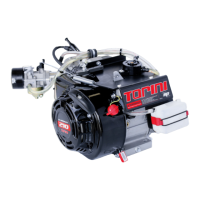JETTING YOUR CARBURETTOR
(Cylinder head 230~240°C)
ENGINE IDLE SPEED - 2,000RPM
•
Using a screwdriver, turn clockwise
•
Using a screwdriver, turn an-clockwise
The carbureor is supplied with
. In many cases, this would be considered as a rich
seng but is done to protect against running the engine too lean
straight out of the box.
, in areas less than 300m above sea level
and with temperatures above 20°C, we suggest starng with a 94
Main Jet and a 40 Pilot Jet.
The carbureor mixes fuel and air at a precise rao, before it goes into the engine to be burnt.
When the fuel air mixture is correct, the engine performs at its best. However this precise fuel air rao is aected by a
number of outside inuences, most signicantly – altude (air pressure) and temperature, but is also aected to a lesser
degree by humidity.
The factory supplied jeng is a starng point only; for opmum performance you will need to read the spark plug and
engine temperature under track condions to determine the opmum jet sizing required.
Racing on tracks that are more than 300 meters above sea level, or in a dierent temperature range (+ - 10°C), requires
that you re-jet your carbureor to compensate.
Going higher results in lower air pressure (lower air density). When racing at higher elevaons your engine is geng
less air, so it needs less fuel (a smaller jet) in order to maintain the correct fuel/air rao. Under such condions your
horsepower will also go down, this is both unavoidable and universal for all competors, you can gure on losing about
3% of your engine power for every 300m (1000 ) of elevaon.
Now if overnight it gets really COLD! You should also be thinking about re-jeng again! Cold air is dense air, and dense
air requires more fuel (a bigger jet). The jet you won the race with yesterday aernoon (when it was hot), will be too lean
now, you need a bigger jet to run properly when it’s cold. Air temperature makes that much dierence! If the temperature
is just 10 degrees colder than it was when last you raced, then you risk damaging the engine by running too lean, if you
don’t change to a larger main jet.
The Main Jet; is the most crical for ensuring full power operaon, correct engine temperature and thereby a long engine
life.
The Pilot jet and the low-speed idle mixture screw; work together, the pilot jet controls the amount of fuel available and
the low-speed idle mixture screw allows you to precisely control the idle mixture being allowed into the engine at idle.
The choke lever opens and closes the
choke valve in the carburetor.
START
RUN

